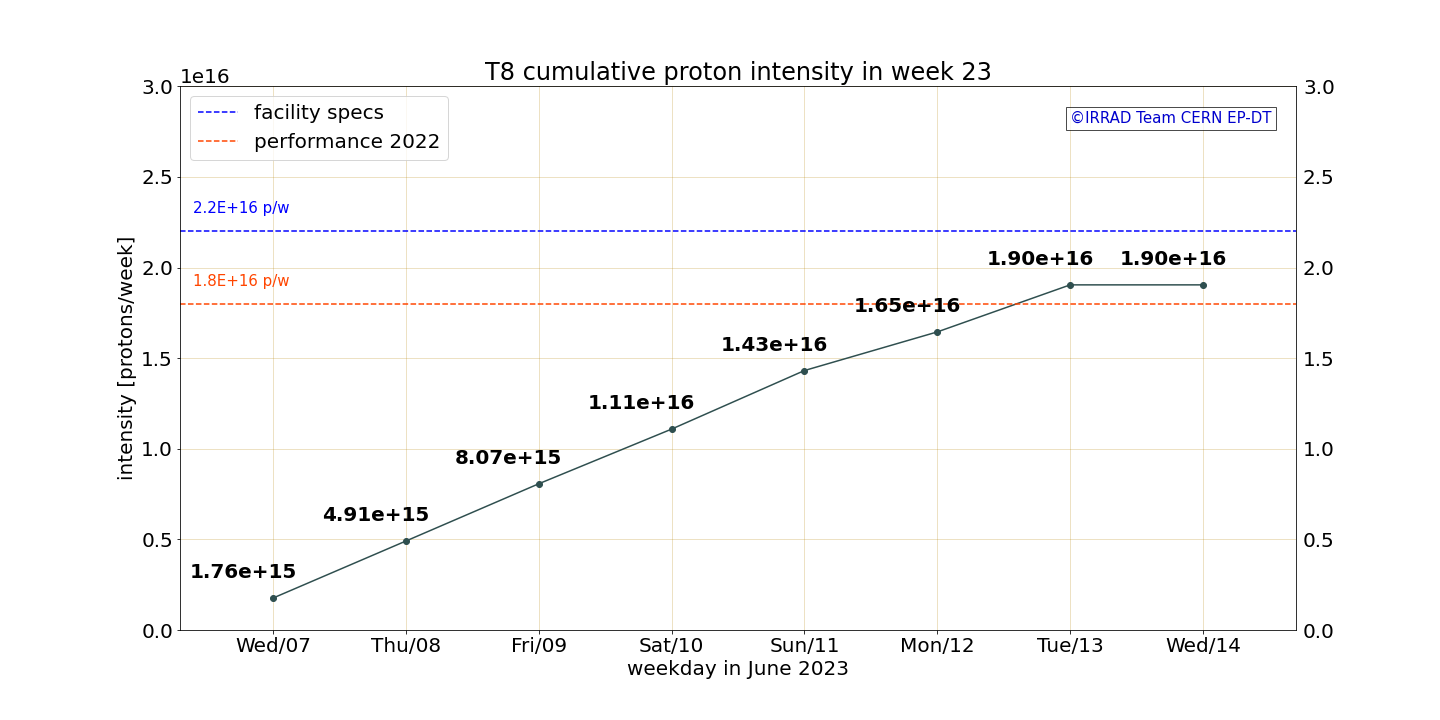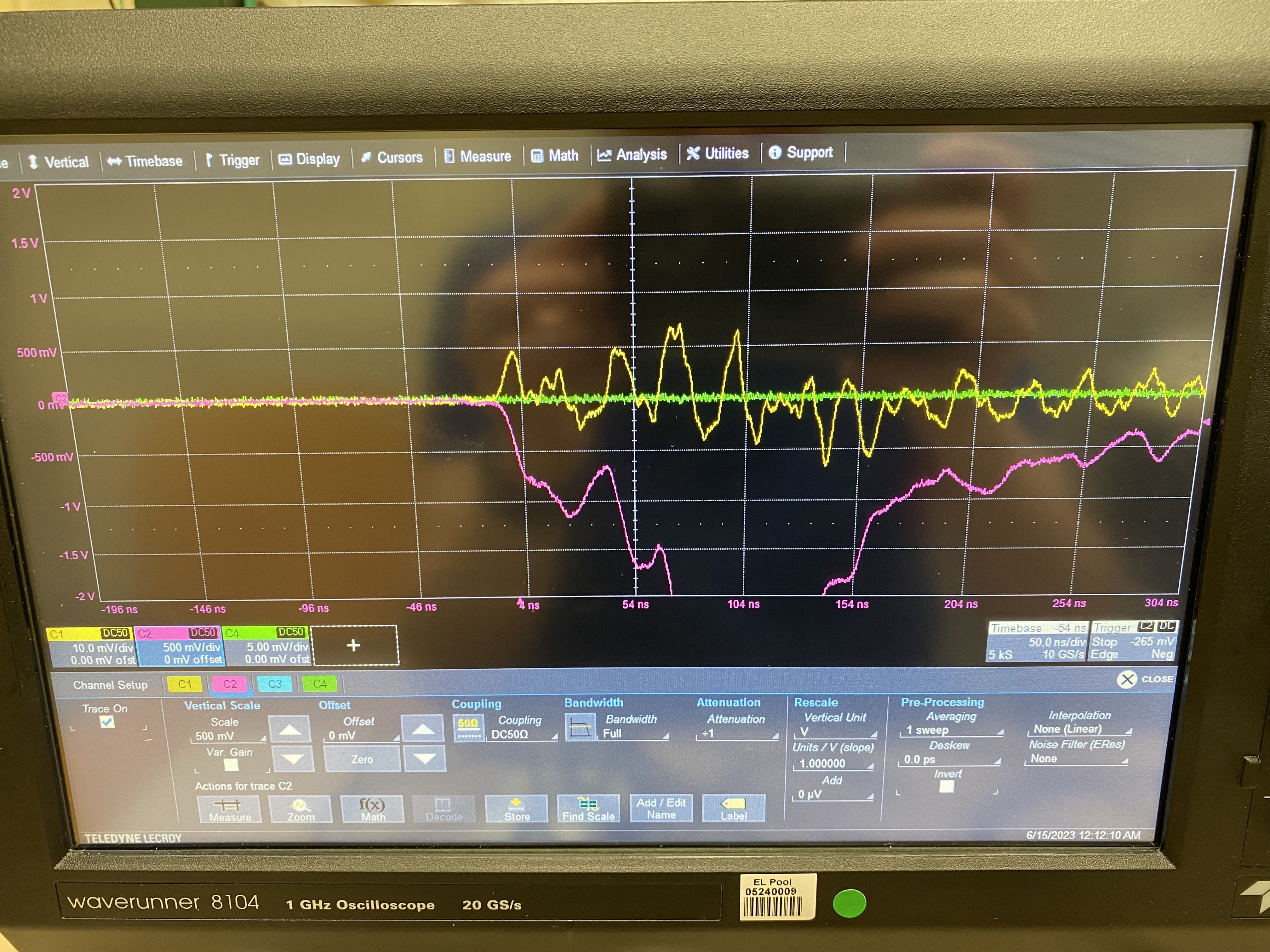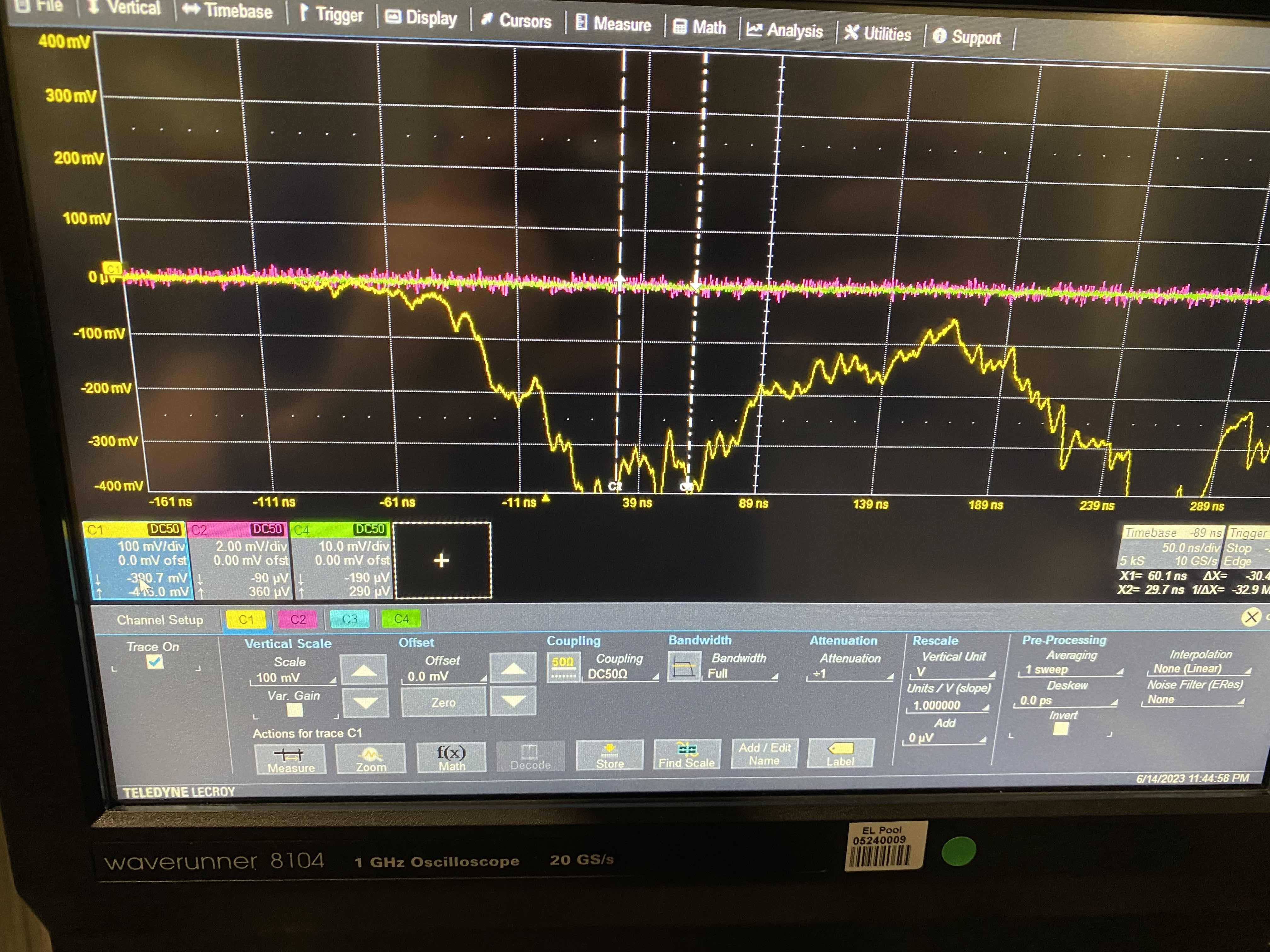
Next user meeting:
For week 25 on Thursday, June 22th, 2023 10:30 CEST
Meeting room 874/1-011
Continued empty-bucket channelling test on the operational beam (improve the spill structure) to be , possibly on Wednesday
This week (week 24):
Week 25 - Technical stop:
Week 26:
no dedicated MDs due to HiRadmat
Beam stop (cool-down) times as a function of beams and areas:
There are big uncertainties with respect to the time when the beams will be ready again for the users!
Availability of 91% since last Thursday.
Main issues:
TOF
Now sending only 28ns bunch length at extraction for the next two month (incl. parasitic TOF)?
New flux limit for nTOF target at 220e10 p/s!?
On Monday, Fabio Pozzi (RP) noticed that the average beam intensity of the TOF beam sent to the target went up to 250e10 p/s for few hours, instead of 220e10 p/s allowed by the new limit. While investigating, the SIS interlock was decreased.
In fact, the beam sent from parasitic cycles were systematically measured at 0 current, and this was due to a timing that was enabled by mistake on the EAST users on Friday, while it was used for testing the double-extraction TOF cycle.
This timing was disabled, and the correct behaviour of the system was checked. and the SIS threshold was put back to 220e10 p/s. On Tuesday, we have set the timing to ’non-trimmable’ in LSA to avoid this situation in the future. Since the limit is set to protect the target, an independent measurement would be desirable, potentially radiation monitoring that could interlock the beam. To be followed up.
EAST
Federico said at MPC that EAST-T8 intensity was low on Monday, this was corrected.
SFTPRO
Correlation between the PS temperature increase, LHC filling supercycle and degradation of beam SFTPRO beam in the PS identified.
Last week’s availabililty for NA was about 79%, this week so far about 84%. Reduced duty cycle because of LHC MD week. n x 50 Hz controller issue on Sunday not understood, but was straight forward to recover. Did not re-occur since then.

T9: Smooth operation.
T10: Smooth operation.
T11: Off for now, no user.
Good week. During the access on Wednesday we exchanged samples for long-term users (EP-ESE, etc.) and replaced samples for the TE-MSC radiation-test under N2 atmosphere (IRRAD). ATLAS, SY-BI, CMS, BE-CEM users continue their tests (CHARM). Some beam stops over the weekend (degraded transmission and beam alignment on X-axis, down to about 72% compared to >96% of previous weeks) solved on Monday morning. Intensity close to the weekly target value (see below). Upcoming access, next week.
FoCal-E standalone installed on DESY table and triggered via scintillator system (10x10 cm2 and 1x1 cm2). The trigger is processed through a Trigger board that allows to select phase of the Local Trigger Unit clock (LTU) and send the trigger out to the LTU.
The LTU triggers the acquisition through the standard ALICE readout chain (CRU —> optical connection to the FEE).
Data taking went smooth, aside multiple hardware issue that needed to be addressed.
Smooth installation yesterday, safety clearance at 17:30.
NanoCal installed on XSCA table. 5 prototypes to test. Each 3 hrs with electrons + 8 hours muons.
Crilin (HIKE SAC prototype) installed on DESY table. Mainly parasitic test of readout and functionality in preparation for H2 in August.
Ambitious program to complete before TS on Monday!
Smooth running overnight: muon run with first prototype.
Problems with CESAR: Unable to load beam files; system errors for various operations. For now calling CCC to ask for CESAR operations. Looked at with Maarten; need to coordinate with Bastien.
Purpose of the testbeam is the calibration of the MUonE ECAL module in the 1-10 GeV range with electrons. The same module collected data two weeks ago at the H2 beamline for the high energy calibr.
The ECAL is on a DESY table for x-y movements.
We replicate the same setup used on the last year test in T9.
Electron energies: (10)- 6 - 5 - 2 - 1 GeV (in this or in reverse order).
Beam intensity: a few 10^3/spill with momentum spread at minimum possible.
We probably need to use the Cherenkov beam detectors for PID at high energy.
Purpose of the testbeam is to test the performance of the cluster counting technique at low momentum by using 20 drift tubes arranged in box. A mixture of He and Isobuthane will be used with different percentage.
The detector will be installed on a DESY table; a rotating table provided by use will be used to change the orientation of the tubes w.r.t the beam line. We will need to change the muon momentum within the range allowed.
H2: Smooth operation.
H4: Smooth operation.
H6: Smooth operation. Higher intensity week. Successfully optimised beam size in PPE156 with EP PIXEL. This week, back to normal intensity. Thanks to EP PIXEL and ALICE ITS3 for nice coordination of the intensity settings - no accidental trips of radiation monitor.
H8: Smooth operation. LHCb and STI installed, both agreed to give control of the beam to the LHCb control room. Agreement to give TOTEM (main) the control, should they need beam any time.
M2: Successful tuning and preparation for all hadron beam energies.
P42/K12: No issues on the beamlines. Running at nominal intensity.
The weekend was very productive as a result of good quality beam in the triple spill, 14.4 s supercycle. Since Monday, we’ve managed during the LHC MD studies and were pleasantly surprised by the quiet periods of triple-spill beam. We also appreciate the operators correcting the worst features of the beam–mainly intensity spikes at the beginning of the spill–quickly and hope that they are not too annoyed by our phoning when these spikes appear. The attached plots are intended to show the effect on the experiment of poor beam quality.
We have concluded the 100 GeV and 250 GeV data points and the 160 GeV data taking is ongoing.
We are currently in access to replace a Wiener VME PS used by CEDARs, otherwise spectrometer is fine.
Empty bucket channelling test on Wednesday morning:
3 spill deliveries per supercycle are welcome to help us fulfill our goals.
External intervention on the CEDARs diaphragms control scheduled for TS.
Successfull data taking during the 4d testbeam.
and 150 𝜋+
Smooth installation and area closed by 5 PM. Safety clearance obtained at 2:30 PM and Alignment from 3 to 4:30 PM. THanks to the craning team, Nikos, Bastien, Michael, Alex and Benoit. Thanks also to the previous users to allow us for using part of the CR for early installation of our DAQ. Unfortunately - all the effort was crippled by major issues of cross-talking between the line of the patch panel. Any signal from the ZDC would (different modules) would induce widespread interference on the other channel, with non negligible magnitudes. None of these issues was present with the same setup last year in H4. After reaching certainty of the source of the issue, we had no choice more than moving the whole setup from the CR to next to the fence. We started at 4:30 AM and we are mostly finished now.
We will then check the quality of the beam and iterate with Nikos for further tuning. This was not possible before because of the issues on our end. The rates that we have seen so far will allow only a very “slim” program. We may ask to squeeze a bit more the beam if possible, but this will be discussed after first good data are taken.
From Sunday 4PM till the end of Wednesday the contact person for the test beam will be the ZDC project leader, Brian Cole (brian.cole@cern.ch).
More about patch panel issue
Example of cross talk between one ZDC line (solicited by a typical activation signal) and another patch panel line reading out a detector channel. Such pick up was seen on several PP lines (either connected or not) and was induced by signals coming from the ZDC modules (any of them - most probably because way larger than the RPD one). Same trend observed during physics. We couldn’t operate in these conditions.

Example of similar ZDC activation signal but measured in the area. No issue visibile in several minutes of test. Also signals looking fine after moving the equipment next to the fence.

Ready for installation. Nothing to report.
Beam configuration desired:
of 150 GeV/c (to get 𝜇−
Smooth data taking.
Monday, 2 shift – Ecal calibration with 50 and 100 GeV electrons; measurement shower profiless for both energy.
Near 3.5x10^11 electrons on target was recorded until today.
Test completed as expected, recorded more data than planned thanks to excellent beam, thanks a lot.
We would also like to thank the groups sharing the beam with us for the collaboration.
Installing the equipment at the test beam area, progress as expected. One day delay for transporting the chiller to the beam area though, since it was labelled as “TREC” and we needed to reissue the transport request. No impact on the schedule, being the first test beam of the activity, we anticipated a 2-day period for completing the installation of the equipment. Not having the chiller implies though a 24 hours delay on the safety review.
The initial plan that was to give to LCHb plenty of freedom to use our main suer slot, will become limited until we have tested all detectors. This means four Quarters of the nT2 telescopes of TOTEM.
Initialy we (TOTEM/LHCb) agreed that it might be changes to the initial plan, in short notice and now this is the case.
We hope to complete all the test in a couple of days and give the rest for LHCb to use.
The setup in PPE128 is installed and complete: goniometer and 5 plane telescope.
Still an issue with communication to be solved, then we can commission the detector.
Start of data-taking sometime between today late afternoon and tomorrow.
Installation went fine. Nothing to report.
UA9 will follow STI next week with the same identical setup.
Reporting for parasitic users is optional, please add your name below:
Minutes by the respective speakers, edited by E. B. Holzer and M. Schwinzerl